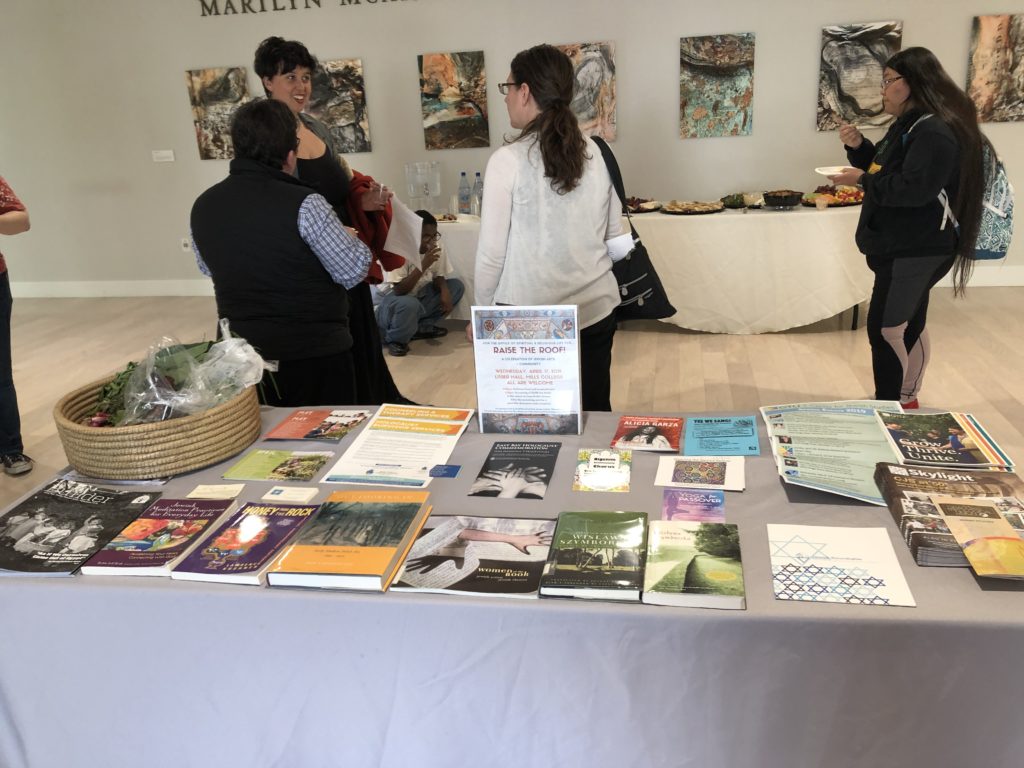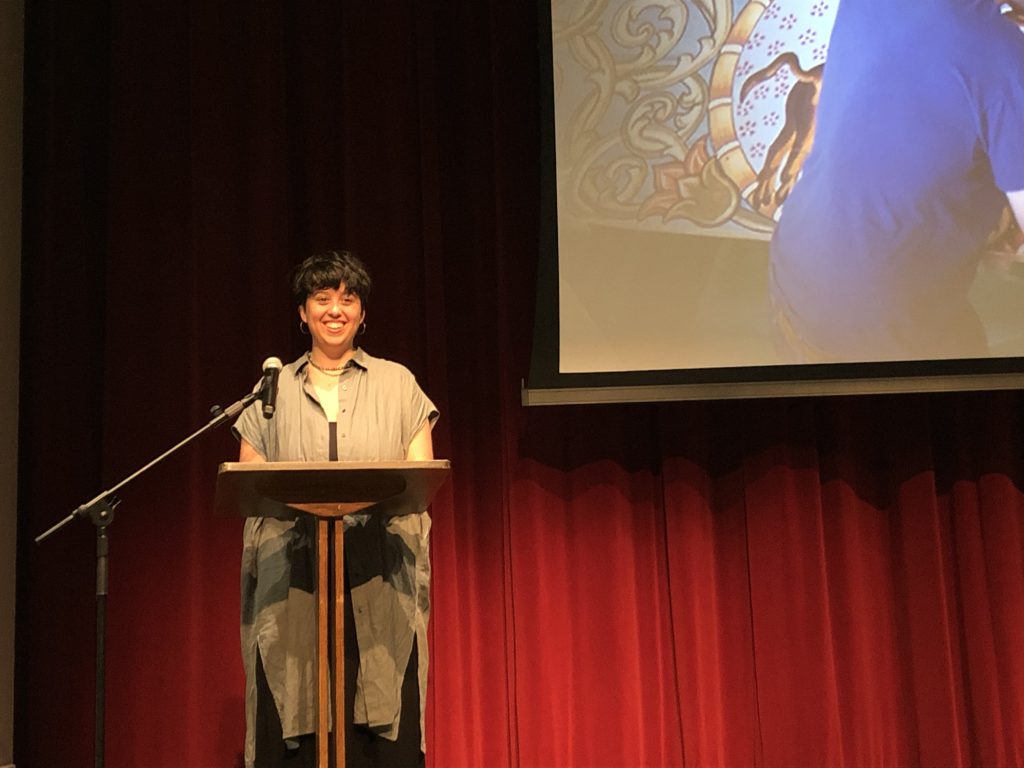On Wednesday, April 16, members of the Mills Jewish community gathered in Lisser Hall to socialize, celebrate art and life and watch the documentary “Raise the Roof” about the wooden Gwoździec synagogue built almost entirely by hand in Poland. The event was also a chance for student Tal Mor to share her experiences on a recent trip to Poland, which centered around Jewish resilience.

Jewish Student Collective (JSC) President Ari Yovel, who uses they/them pronouns, had a large role in planning the event and selecting the film, along with the Department of Spiritual and Religious Life (SRL).
“I watched it, and I was totally floored,” they said, describing the decision to share the film with the campus after it was donated by Taube Foundation, which also sponsored Mor’s trip to Poland.
“As a Jewish person, a historical reenactor, as an artist, it’s something that hit really close to home for me. I needed everybody to see it, and I’m so thrilled that more people are going to get the chance to see it now,” Yovel said.
Rev. Dara Olandt, the Mills chaplain and director of SRL who identifies as both Jewish and Unitarian Universalist, also had a role in putting on the event.
“As I watched this particular film, I was struck by — in these incredibly politically polarizing times — how crucial it is to lift up stories of artistic resilience: stories in which people are coming together across differences in a shared, creative project that affirms beauty, power, memory, restoration of hope and restoration of memory in concretized forms,” she said to the audience before the film began. “I hope that there will be something that you hear tonight that you can take with you that will effuse your life positively, that will stir your imagination, your heart, in connecting with your own history and with your own story.”
In the 17th and 18th centuries, around 200 wooden synagogues were built in Poland and by 1942, they had all been destroyed by the Nazi invasion. The Gwoździec Synagogue had been most thoroughly documented by photos, and over the course of 10 years, Handshouse Studio (led by Rick and Laura Brown) gathered hundreds of students from over a dozen countries to rebuild it using the same methods from the time it was built. In particular, the documentary showcased the creation of the intricate structure of the roof and the paintings on the inside of it — hence the title.
But this project, this documentary and certainly this event at Mills were not focused on the end product, nor did they focus on the destruction of the original synagogue and all that had been lost. Rather, the focus was on community, the authentic creation of art and the celebration of Jewish life and resilience.
Rev. Olandt welcomed those who wanted a space to debrief and discuss the film and its ideas to stay afterwards.
“I love that they didn’t end on the grand reopening — they end on the people who worked on it lighting candles and silently and in awe beholding what they had helped create,” Yovel said after the film. “There wasn’t a need to talk about it, even, because their being together to look at it said everything that had to be said.”
Rev. Olandt agreed.
“It was about that which was larger,” she said. “It didn’t even need to be expressed what the larger was other than the concrete shared project.”
The event provided a space for the Jewish community to gather and reflect. Chaplaincy intern Hillary Sklar, who has been working with Rev. Olandt and the department of SRL remarked that seeing the film during this event was different than watching it on her computer recently.
“I had another experience this evening watching this very visceral experience, not just to see the film, but being in this space — it’s a physical, emotional and visceral [experience] seeing the vividness of the colors,” Sklar said, “seeing it large — but also being in this room of many Jews and having collective memory be part of what’s resonating in the room…something very significant happens.”
Sklar had a chance to reflect with other members of the community.
“[Mor] and I were talking about memory, and intergenerational memory — that’s also present in this room,” Sklar said.

on a recent trip to Poland funded by the Taube Foundation.
Junior Tal Mor, who had a chance to see the featured synagogue during her recent educational trip, shared the highlights of the experience during this same evening.
“My favorite aspect of the trip was the focus on Jewish resilience and revival in Poland,” she said. “Its primary angle was about asking questions about how the echoes of the past impact the Jewish present and future in Poland and beyond. We were challenged to think critically about physical sites of memory, about what the appropriate ways are to honor the violence enacted and endured in certain locations, and about the potential to transform destroyed sacred spaces into spaces of healing.”
Creating spaces for collective healing is important to the Jewish community at Mills, and students discussed the need to balance grieving losses of life and tragedy with past and present vibrancy, creativity and resilience in Jewish communities. Students were particularly moved by a statement in the film made by Barbara Kirshenblatt-Gimblett, who serves as the program director at the Museum of the History of Polish Jews, which is where the synagogue can be viewed today.
“When people ask me, ‘What is the most important period in the history of Polish Jews?’ it’s usually because they already know. ‘Oh, yes. It’s the Holocaust.’ I have one answer,” she said in the film, “My answer is, ‘The most important period in the history of Polish Jews is 1,000 years.’”
This quote particularly resonated with students, both Jewish and non-Jewish, who expressed frustrations over mainstream education of Jewish history.
“In my imagination, Poland was part of a horrific Jewish past, though theoretically I knew there were still Jews in Poland, I don’t think I really believed it before being there and witnessing the incredibly brave work of healing and rebuilding that Jews in Poland are doing right now,” Mor said, reflecting on her trip.
Kirshenblatt-Gimblett remarked that if all of the focus remains on the Holocaust and other tragedies, “then the world will know more about how Jews died than how they lived.”
The department of SRL and the JSC aim to celebrate Jewish art, culture and community through events like this one and hopefully more to come.
“My job is to help create events that promote spiritual health and wellness on-campus, because I think people oftentimes forget that part of social justice and part of any good activism is also nourishing the self and nourishing your spiritual well being,” Yovel said. Besides serving as the president of the JSC, they work as a spirituality and social justice coordinator in the department of SRL.
“It’s a lot of interfaith work across different axes of student life and student identity in order to help create spaces for people to replenish their spiritual selves, to talk about some heavy issues, and to really delve deeper into what meaning-making — which is that term we use a lot at SRL — looks like from a social justice perspective,” they said of their job. “Not talking about just what we have to do, but also why we do it and how we do it well.”
